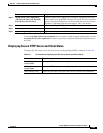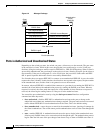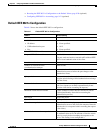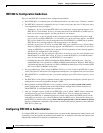
9-7
Catalyst 2960 Switch Software Configuration Guide
78-16881-01
Chapter 9 Configuring IEEE 802.1x Port-Based Authentication
Understanding IEEE 802.1x Port-Based Authentication
With the multiple-hosts mode enabled, you can use IEEE 802.1x to authenticate the port and port
security to manage network access for all MAC addresses, including that of the client.
Figure 9-3 Multiple Host Mode Example
Using IEEE 802.1x with Port Security
You can configure an IEEE 802.1x port with port security in either single-host or multiple-hosts mode.
(You also must configure port security on the port by using the switchport port-security interface
configuration command.) When you enable port security and IEEE 802.1x on a port, IEEE 802.1x
authenticates the port, and port security manages network access for all MAC addresses, including that
of the client. You can then limit the number or group of clients that can access the network through an
IEEE 802.1x port.
These are some examples of the interaction between IEEE 802.1x and port security on the switch:
• When a client is authenticated, and the port security table is not full, the client MAC address is added
to the port security list of secure hosts. The port then proceeds to come up normally.
When a client is authenticated and manually configured for port security, it is guaranteed an entry
in the secure host table (unless port security static aging has been enabled).
A security violation occurs if the client is authenticated, but the port security table is full. This can
happen if the maximum number of secure hosts has been statically configured or if the client ages
out of the secure host table. If the client address is aged, its place in the secure host table can be
taken by another host.
If the security violation is caused by the first authenticated host, the port becomes error-disabled and
immediately shuts down.
The port security violation modes determine the action for security violations. For more
information, see the “Security Violations” section on page 21-9.
• When you manually remove an IEEE 802.1x client address from the port security table by using the
no switchport port-security mac-address mac-address interface configuration command, you
should re-authenticate the IEEE 802.1x client by using the dot1x re-authenticate interface
interface-id privileged EXEC command.
• When an IEEE 802.1x client logs off, the port changes to an unauthenticated state, and all dynamic
entries in the secure host table are cleared, including the entry for the client. Normal authentication
then takes place.
101227
Wireless clients
Access point
Authentication
server
(RADIUS)


















